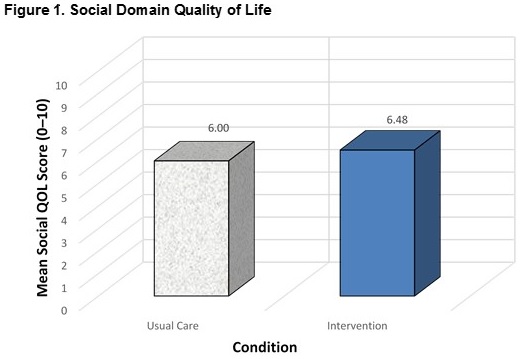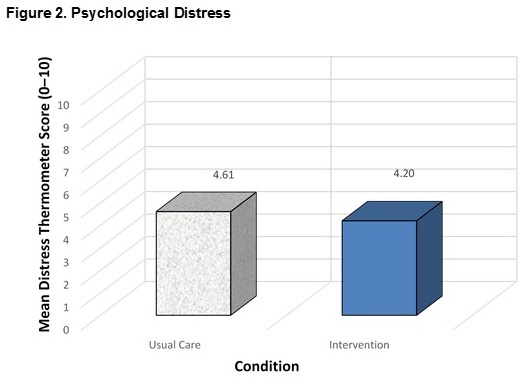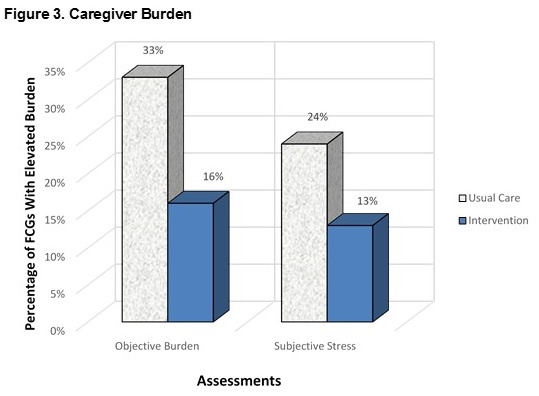The Implementation Guide is a resource for implementing this evidence-based program. It provides important information about the staffing and functions necessary for administering this program in the user’s setting. Additionally, the steps needed to carry out the program, relevant program materials, and information for evaluating the program are included. The Implementation Guide can be viewed and downloaded on the Program Materials page.
Program Synopsis
Designed to enhance the quality of life (QOL) for caregivers of individuals with cancer, this intervention has three key components: a baseline assessment with the caregiver to create a personalized palliative care plan, a case presentation to an interdisciplinary team to make recommendations for supportive care referrals and community resources, and four nurse-led one-on-one educational sessions addressing self-care and QOL. The study showed an increase in QOL and decreases in psychological distress and caregiver burden.
Program Highlights
Program Materials
Preview and order the materials from the developer
Implementation Guide
Download Implementation Guide
Featured Profile
Learn more about this program and the developer who created it
Program Scores
The Need
In the United States, lung cancer is the primary cause of cancer-related death and the second most common type of cancer. Approximately 150,000 people die each year from lung cancer, and non-small cell lung cancer (NSCLC) accounts for 85% of lung cancer cases. Lung cancer patients are often cared for and supported by family caregivers (FCGs), which can include friends who serve as a primary caregiver. FCGs are an integral part of the treatment patients receive in outpatient and home settings. Caregivers may feel overwhelmed by the responsibility of caring for an ill loved one while fulfilling their normal obligations, such as work. They may feel additional stress out of fear and worry as well as uncertainty about how to help their loved one. The stress and burden on caregivers can affect their own health, especially if they lack social support.
Palliative care can help improve the quality life (QOL) of FCGs of lung cancer patients, regardless of the patients' disease stage. (Based on the size, location, and progression of the tumor, patients are assigned a stage of cancer: occult [hidden stage], Stage 0, Stage I, Stage II, Stage IIIA, Stage IIIB, and Stage IV.) Providing palliative care for caregivers aims to reduce caregiver stress, help caregivers cope with challenges, and protect their own health.
The Program
Palliative Care Intervention for Caregivers of Lung Cancer Patients is an interdisciplinary intervention that strives to improve quality of life, psychological distress, and caregiver burden among FCGs of patients with Stage I-IV NSCLC. Elements of the intervention are taken from the National Comprehensive Cancer Network's Guidelines for Distress Screening, Institute of Medicine's Report on Cancer Care for the Whole Patient, and the National Consensus Project for Quality Palliative Care's Clinical Practice Guidelines for Quality Palliative Care, which provides guidance on palliative care using a patient- and family-centered approach.
The intervention has three key components. First, a nurse meets with the FCGs (as well as the patients) to complete a comprehensive baseline assessment that includes QOL and psychological distress. This assessment is used to create a personalized palliative care plan that includes four domains of QOL: physical, psychological, social, and spiritual. Second, FCGs' cases are presented at a weekly meeting of the interdisciplinary team (IDT), which includes nurses, palliative medicine physicians, thoracic surgeons, medical oncologists, a geriatric oncologist, a pulmonologist, a social worker, a chaplain, a dietitian, and a physical therapist. Using the comprehensive QOL assessment as a guide, the IDT makes recommendations for supportive care referrals and community resources. Last, FCGs receive four nurse-led, one-on-one educational sessions addressing self-care and the QOL domains. The sessions are tailored to individual caregivers in that caregivers select the session topics to discuss from a list of options. Caregivers receive an educational manual containing information on all the QOL domains. During these sessions, the nurse also discusses the supportive care resources the IDT recommended.
The nurses who complete the baseline assessments and educational sessions have at least 20 years of experience in oncology. Palliative Care Intervention for Caregivers of Lung Cancer Patients is designed to be implemented in conjunction with Palliative Care Intervention for Lung Cancer Patients. The patient intervention aims to improve symptom management and quality of life for lung cancer patients.
Time Required
-- Approximately 20-30 minutes for completing the baseline assessment
-- Approximately 15 minutes per FCG for presentation at one IDT meeting
-- Approximately 30 minutes for each education session
Intended Audience
The intervention is intended for caregivers of patients with Stage I-IV NSCLC.
Suitable Settings
The intervention is suitable for implementation in clinics in rural, suburban, or urban/inner city settings.
Required Resources
Required resources to implement the program include the following:
--Palliative Care for Family Caregivers of Patients Living With Lung Cancer [caregiver manual]
--PC1 Interdisciplinary Care Plan
For costs associated with this program, please contact the developer, Betty Ferrell. (See products page on the EBCCP website for developer contact information.)
About the Study
A quasi-experimental trial was conducted to assess the intervention in comparison with usual care with caregivers of patients with Stage I-IV NSCLC receiving cancer-related treatments at the City of Hope, a comprehensive cancer center in Duarte, California. Primary caregivers of patients in the outpatient thoracic surgery and medical oncology clinics were sequentially enrolled into the study, such that FCGs were assigned to the usual care group from November 2009 to December 2010 and the intervention group from July 2011 to August 2014. The patients were classified as early stage (Stage I-IIIB) and late stage (Stage IV) of NSCLC. FCGs who were at least 21 years old and who were caring for a patient were eligible to participate.
Of the 366 FCGs who completed the baseline assessment, 38% were men and 62% were women. Seventy-seven percent of the participants were White, 11% were Asian, 3% were Black or African American, 3% were Native Hawaiian/other Pacific Islander, less than 1% were American Indian/Alaska Native, and 5% were "Other." For more than half of FCGs, 79%, were married or had partners, 13% were single, and 8% were separated, widowed, or divorced. And for more than half of FCGs, 59%, made more than $50,000 per year, 21% of participants made less, and 20% preferred not to answer.
Significant baseline differences existed between the study groups on the variables of work hours and race/ethnicity.
The study's primary outcomes were caregiver quality of life, psychological distress, and caregiver burden. Outcomes were measured using the following instruments:
-- QOL domains were measured with the FCG version of the City of Hope QOL Tool (COH-QOL-FCG). This assessment has 37 items addressing physical, psychological, social, and spiritual domains. The total score in each domain ranges from 0 to 10, with higher scores representing better QOL.
-- Psychological distress was measured with the Distress Thermometer (DT). The total score ranges from 0 to 10, with higher scores representing more distress.
-- Caregiver burden was measured with the 14-item Montgomery Caregiver Burden Scale. This assessment measures three dimensions of burden: objective burden, subjective demand, and subjective stress. The total score ranges from 6 to 30 for objective burden, from 4 to 20 for subjective demand, and from 4 to 20 for subjective stress, with higher scores representing higher burden. The study assessed the percentage of intervention and usual care participants reporting "quite high" caregiver burden.
Data were collected using these instruments at baseline and 7 and 12 weeks. The data used in the primary analyses were collected at the 12-week follow-up.
Key Findings

- At 12-week follow-up, FCGs in the intervention group had better QOL in the social well-being domain in comparison with those in the usual care group across disease stages (p<.001).

- At 12-week follow-up, FCGs in the usual care group had greater psychological distress in comparison with those in the intervention group across disease stages (p=.01).

- At 12-week follow-up, a smaller percentage of intervention group participants than usual care group participants reported an elevated objective burden (16% vs. 33%; p<.001) and elevated subjective stress (13% vs. 24%; p=.008).
Additional Findings
- Within the QOL domains assessed, no significant differences were found between the intervention and usual care groups in the physical and psychological domains. In the spiritual domain, the usual care group had significantly higher spiritual well-being than the intervention group at follow-up (p=.043).
- Within the assessments of burden, no significant differences were found between the intervention and usual care groups on subjective demand.


